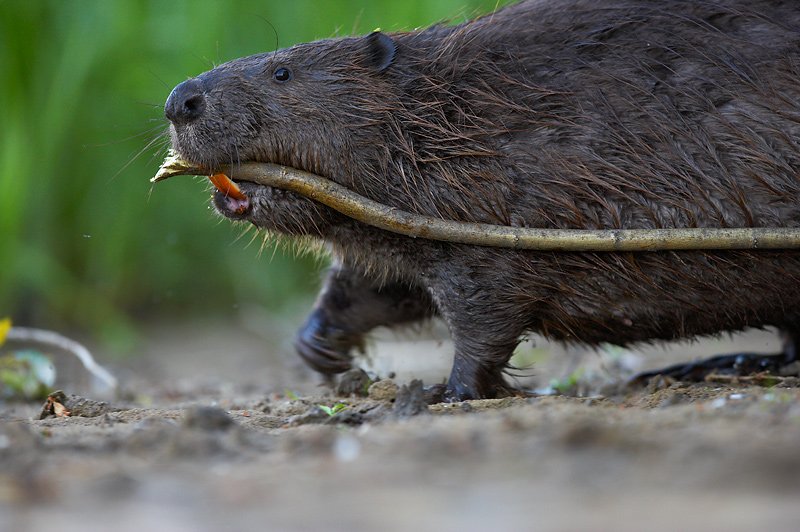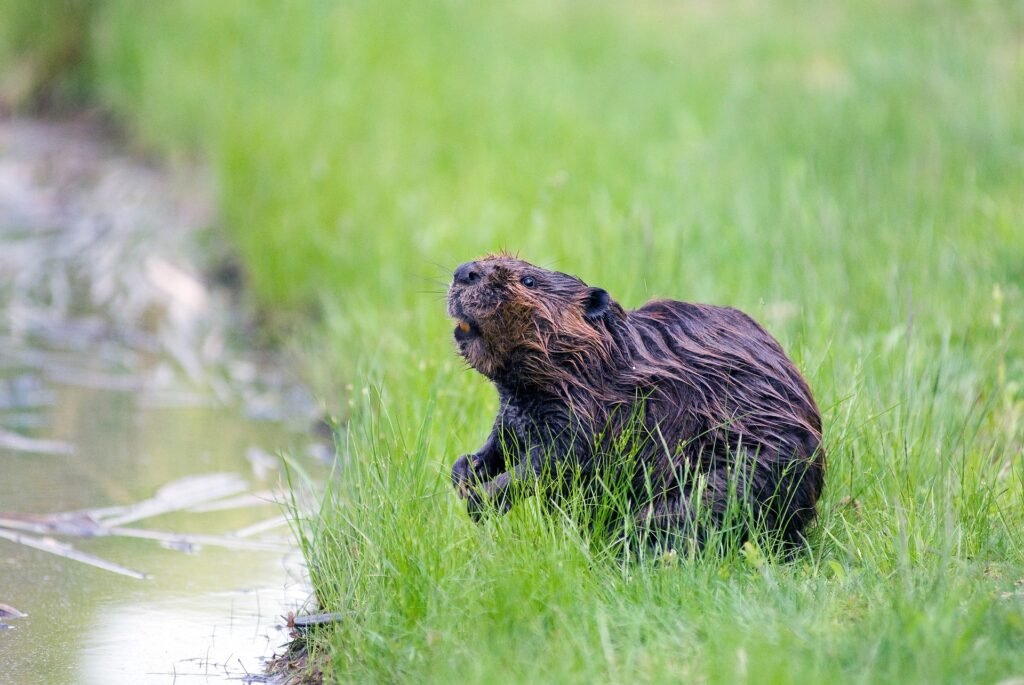Beaver Trapping Services

Beavers are considered highly beneficial to local ecosystems, but they have been known to cause various problems for homeowners in the United States. Flooded lands, flooded timber, the destruction of valuable trees, and massive levels of interference with property drainage units are all common damages. The cost of repairs for beaver damage is estimated to be $23 million per year.
When dealing with beavers, you should be aware that they are known for their intelligence. They can climb on almost anything, including steps, ladders, and drainage components, to gain access to plants, trees, and other materials needed for the construction of their dams.
Beavers will climb on sticks, bricks, and other debris and even use their sharp teeth to help them lift. As a result, many homeowners are subjected to a significant amount of damage each year.
Identifying Beavers
 The beaver is North America’s largest rodent, and it was designed to live in the water. The two species of beavers found in the United States include the Eurasuan Beaver and the North American Beaver. Adults beavers grow to be over four feet long and weigh more than 60 pounds. The beaver’s hind feet are webbed, and his tail is large, flat, and nearly hairless. When it’s gnawing on trees, it uses its tail to keep itself balanced. It will also slam its tail against the water to warn predators away or signal danger. The front legs of the beaver are short and have heavy claws. Their back legs are longer, and they propel themselves through the water with their rear webbed feet. The beaver’s nose and ears close up, and a special membrane covers its eyes when it is submerged.
The beaver is North America’s largest rodent, and it was designed to live in the water. The two species of beavers found in the United States include the Eurasuan Beaver and the North American Beaver. Adults beavers grow to be over four feet long and weigh more than 60 pounds. The beaver’s hind feet are webbed, and his tail is large, flat, and nearly hairless. When it’s gnawing on trees, it uses its tail to keep itself balanced. It will also slam its tail against the water to warn predators away or signal danger. The front legs of the beaver are short and have heavy claws. Their back legs are longer, and they propel themselves through the water with their rear webbed feet. The beaver’s nose and ears close up, and a special membrane covers its eyes when it is submerged.
A beaver’s back and sides are dark brown, while its chest and belly are lighter brown. Castoreum, an oily secretion from the beaver’s scent glands, is used to waterproof its thick fur. Under its skin, the beaver has a thick layer of fat that helps it stay warm underwater. Beavers have long, sharp incisor teeth that they use to cut into trees and other woody vegetation. The beaver’s teeth continue to grow throughout his life. 1Go To Source pbs.org -“Beaver – Castor canadensis”
Beaver Lifespan
Beavers can live up to 20 years in captivity and have a lifespan of 10-15 years in the wild.
North American beavers only have one litter per year, and they only come into estrus for 12-24 hours between late December and May, with January being the busiest. Beaver pairs, unlike most other rodents, are monogamous, remaining together for multiple breeding seasons. They have a gestation period of 128 days and a litter size of three to six kits (usually 4-5). The majority of beaver females do not reproduce until they are three years old, but about 20% of two-year-old females do. 2Go To Source naturemappingfoundation.org -“Beaver”
Predators Of The Beaver
- Wolves
- Bears
- Wolverine
- Coyotes
- Lynx
- Otters (Prey On Young Beavers) 3Go To Source gov.nl.ca -“Beaver”
Habitat Of Beavers
 Lodges are where beavers live. They will either live in a lodge built on an island, on the shore of a pond, or on the shore of a lake. The lodge’s main room has a floor that is above water. There are two ways to enter the lodge.
Lodges are where beavers live. They will either live in a lodge built on an island, on the shore of a pond, or on the shore of a lake. The lodge’s main room has a floor that is above water. There are two ways to enter the lodge.
The oven-shaped lodge is constructed of sticks, grass, moss, and mud. The inside room can be up to 8 feet wide and 3 feet tall. Beavers accumulate more sticks and mud over time (expanding the lodge’s size). The lodge’s floor is made up of bark, grass, and wood chips.
The pond lodge is built either a short distance from the bank’s edge or partially over it, with the front wall rising from the pond’s bottom. The lake lodge is situated on the lake’s shelving shores. Beavers dam streams with logs, branches, mud, and stones to ensure adequate water depth around the lodge. 4Go To Source biokids.umich.edu -“American beaver Castor canadensis”
Beaver Distribution In North America
The North American beaver can be found in Alaska, Canada, the continental United States, and northern Mexico. Northern Alaska, Canada’s tundra, parts of the Midwest, South Carolina, and peninsular Florida are devoid of beavers.
Beavers are only found in arid areas of the southwestern United States along larger streams and rivers. Castor canadensis has successfully been introduced to southern South America and Europe, where it now outnumbers native Castor fiber in some areas. 5Go To Source fs.usda.gov -“North American Beaver (Castor canadensis): A Technical Conservation Assessment”
Beaver Diet
The availability of a food supply largely determines a beaver colony’s survival. Beavers eat a variety of aquatic plants, roots, and grasses in addition to bark. The beavers must forage further away from their homes as the food supply in the area runs out. Predators are more likely to attack as a result of this. When a food source is depleted, the family relocates to a new location. Wolves, lynx, bears, and humans are predators that attack beavers while they forage. 6Go To Source adfg.alaska.gov -“Beaver (Castor canadensis)”
Why Are Beavers Dangerous?
Beavers are experts at building strong dams, but this makes them a nuisance because they can disrupt water flow, flood areas that aren’t supposed to be flooded, and damage existing dams. They also carry diseases like rabies and parasites that can cause blindness and liver failure in humans and pets, which they can transmit to you and your pets through water and bites. These animals also destroy trees for building materials and food, making your property look unsightly and cost you money.
Beaver Damage
 Although you won’t be able to see the beaver, the damage it leaves behind will be evident from the start. Soon after these rodents appear, you’ll notice a slew of signs, including the destruction and chewing of vegetation, including shrubs and trees. You may also notice slides, which are long, sliding mud channels created by beavers. Typically, these will lead directly to the water.
Although you won’t be able to see the beaver, the damage it leaves behind will be evident from the start. Soon after these rodents appear, you’ll notice a slew of signs, including the destruction and chewing of vegetation, including shrubs and trees. You may also notice slides, which are long, sliding mud channels created by beavers. Typically, these will lead directly to the water.
When you see beavers, one of the most important things to keep in mind is the risk of flooding. One of the most common issues with landowners and beaver dams is that removing the dam can be difficult, often requiring industrial machinery. When you’re tearing the thing down, one wrong move can spell disaster. A flash flood could occur, causing property damage as well as putting people and other wildlife in danger. You could be held liable if you are responsible for the dam’s movement, and the water that the dam was holding back floods someone else’s property.
Diseases Spread By Beavers
Giardiasis is a diarrheal disease caused by Giardia parasites, which are microscopic parasites. Many mammals, including humans, can carry these parasites in their intestines. Although there are several species of Giardia, only Giardia lamblia causes infection in humans.
In humans, Giardiasis is a common cause of waterborne disease. After an outbreak in which hikers in Banff National Park became ill after drinking stream water contaminated with Giardia from beavers, Giardiasis is sometimes referred to as “beaver fever.” 7Go To Source health.gov.on.ca -“Giardiasis”
Beaver Removal & Prevention
Controlling and removing beavers can be done in a variety of ways. Because the wetlands created by beaver lodges and dams are essential to local ecosystems, it is illegal in most states to destroy or disturb them. Drainage systems may be built with the help of conservation specialists to control the water level to manage established beaver populations. The most effective method for removing problematic beavers is to use traps. Experts must, however, set traps at the underwater entrances of beaver lodges.
Are Beavers Causing Problems Around Your Home?
If you’ve noticed a beaver’s dam or habitat on your property, or if the nocturnal habits of these animals keep you awake at night, it’s time to call wildlife control experts. Homeowners should seek professional help before these creatures cause thousands of dollars in damage. Beaver control and removal services can help you solve it if you notice a nuisance animal problem.
All of your beaver removal and beaver control issues are in good hands with the help of beaver removal professionals. Animals Happens can provide you with experienced beaver control specialists to assist you with whatever service your home requires. We specialize in keeping unwanted beavers out of your house, yard, and garage. Contact us at 833-633-1120 if you are in need of beaver control, removal, or prevention services.
Sources:
- “Beaver – Castor Canadensis – NatureWorks.” Nhpbs.Org, nhpbs.org/natureworks/beaver.htm. Accessed 16 July 2021.
- “Beaver Facts – NatureMapping.” Naturemappingfoundation.Org, naturemappingfoundation.org/natmap/facts/beaver_712.html. Accessed 16 July 2021.
- “Beaver.” Fisheries, Forestry and Agriculture, 18 June 2020, www.gov.nl.ca/ffa/wildlife/snp/programs/education/animal-facts/mammals/beaver.
- Anderson, R. 2002. “Castor canadensis” (On-line), Animal Diversity Web. Accessed July 16, 2021 at http://www.biokids.umich.edu/accounts/Castor_canadensis/
- “North American Beaver (Castor Canadensis): A Technical Conservation Assessment.” Fs.Usda.Gov, www.fs.usda.gov/Internet/FSE_DOCUMENTS/stelprdb5181919.pdf. Accessed 16 July 2021.
- dfg.webmaster@alaska.gov. “Beaver Species Profile, Alaska Department of Fish and Game.” Adfg.Alaska.Gov, www.adfg.alaska.gov/index.cfm?adfg=beaver.main. Accessed 16 July 2021.
- “Giardiasis – Diseases and Conditions – Publications – Public Information – MOHLTC.” Health.Gov.on.Ca, www.health.gov.on.ca/en/public/publications/disease/giardiasis.aspx. Accessed 16 July 2021.
- Bailey, Vernon; Doutt, J. Kenneth (1942). “Two New Beavers from Labrador and New Brunswick”. Journal of Mammalogy.
- “Beaver Biology”. Beaver Solutions. Archived from the original on April 14, 2010. Retrieved November 22, 2013.
- “Beaver”. Study of Northern Virginia Ecology, Fairfax County Public School. Archived from the original on January 5, 2013. Retrieved January 3, 2013.
